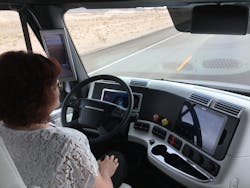Freightliner introduces autonomous vehicle driver certification
LAS VEGAS. For the next milestone on the road to autonomous trucks, Daimler trucks North America this week put trucking industry journalists through driver training and certification in its Freightliner Inspiration Truck.
Jim Martin, manager of Freightliner’s vehicle performance group and the trainer/tester for the event, explained the basics of the Highway Pilot (HWP) system (see the explainer above), and the skills “checklist” that is required for certification. The assessment process was developed for CDL holders by Freightliner and the Nevada Dept. of Transportation.
“We just want to make sure you can handle the vehicle in a safe and appropriate manner,” Martin said. “The important thing to know is to be aware, and be available to take control back from the vehicle at any point.”
The checklist specifies that:
- Driver participates in the training of the system and understands the technology
- Driver must demonstrate knowledge of system capabilities and limitations prior to operating the system
- Driver demonstrates ability to operate vehicle both in normal driving and autonomous driving modes
- Driver knows when the HWP system is available
- Driver demonstrates how to enable/activate HWP
- Driver understands and can demonstrate how to disable and/or take back manual control
- Driver trainee must demonstrate ability to react appropriately to a system error induced by DTNA trainer
- Driver reaction time to system error is 1/2 second or better
- Vehicle trajectory error must be corrected in no more than 2.5 seconds; and
- Lane deviation must be corrected to no more than about 2 feet.
In a road-test loop near the Las Vegas Motor Speedway north of town, HWP is ready to engage shortly after the driver pulls the Inspiration onto the state highway. Martin, from the passenger seat, quizzed the driver who is being certified on the system functions, and he had the driver perform a number of tasks both on the two-lane segment and then on the Interstate 15 return leg.
Suzanne Stempinski, a journalist who’s who logged more than 1.5 million long-haul miles, was the first to be certified. She noted that her time at the wheel was too brief to get comfortable with the technology, but she readily recognized the possibilities. She was particularly intrigued by the steering wheel’s continuous course corrections as a strong desert crosswind buffeted the fully loaded rig.
“I keep thinking I ought to be doing something,” she said as she drove. “It absolutely fascinates me that you have to watch the truck doing things so that you don't have to. At some point I'd expect my stress level to be greatly reduced. Just let your equipment do what's it's intended to do.”
And that’s a key benefit to the system, Derek Rotz, director of advanced engineering for Daimler Truckers North America, explained.
“The way I like to look at it, driving today is like staring at a clock—it’s tedious,” said. “Just having the chance to enjoy the landscape for a moment is a lot more pleasurable, and reduces fatigue.”
Rotz also pointed out that truck systems were still largely manual until very recently.
“It’s hard to believe, even three or four years ago, that we’d be here today,” he said. “That step between a completely manual vehicle and a completely autonomous vehicle seemed really huge.”
But the adoption of various safety systems that have been introduced in the marketplace along the way (such as the new Detroit Assurance package) has made the Highway Pilot technology a reality.
Diane Hames, DTNA’s general manager for marketing and strategy, likens the various technologies, such as multiple cameras and radars, to “bionics” for truckers—giving drivers “beyond human” abilities.
“It’s really about integrating the driver with the truck,” she said. “It’s an extension of the driver’s capabilities.”
Going forward, the focus at Freightliner is “interactive safety,” which will pull together these technologies and coming vehicle-to-vehicle (V2V) and vehicle-to-infrastructure (V2I) communication, along with “big data,” to create an even more interconnected transportation network.
“This is where we’ll see the radical advances. … What you saw today was a number of technologies put together to produce one result: the autonomous vehicle,” Hames said. “This was a showcase of what is possible when we combine these building blocks. But it’s really just wherever your imagination can take you.”
About the Author
Kevin Jones 1
Editor
Kevin has served as editor-in-chief of Trailer/Body Builders magazine since 2017—just the third editor in the magazine’s 60 years. He is also editorial director for Endeavor Business Media’s Commercial Vehicle group, which includes FleetOwner, Bulk Transporter, Refrigerated Transporter, American Trucker, and Fleet Maintenance magazines and websites.
